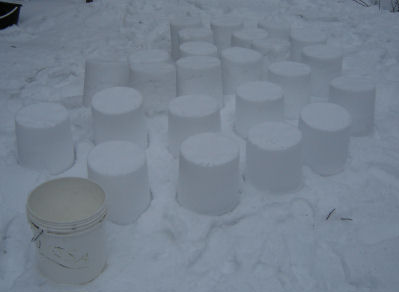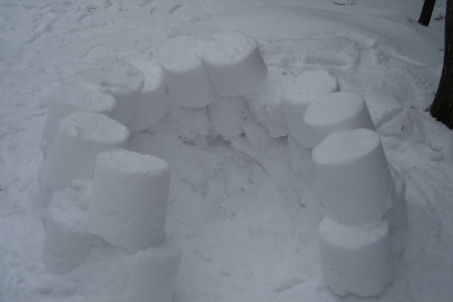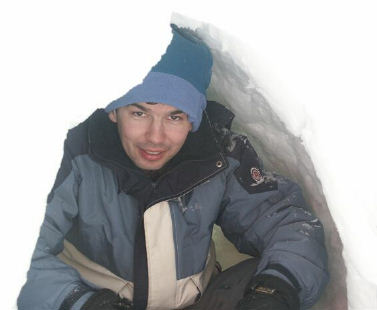Building an igloo with a bucket
In my last igloo building experiment, I found that making blocks by packing snow in a bucket, and then stacking them would probably work for building an ingloo, even if the snow is not sticky. More than a year after my previous experiment, I finally got around to building a test igloo with this method, at Silent Lake provincial park.The snow at the park was less than 5 cm of fluffy powder, on top of a layer of ice that was hard enough that I could walk on and only break through occasionally. Initially, I stomped up the ice, and filled the whole mess, ice chunks and all, into the bucket. After filling the bucket, and pushing down in it a bit, I turned it over. The blocks looked ugly, but barely held together. I made about 10 blocks this way. I made more blocks by scraping together the fluffy snow from the surrounding area and filling the bucket with that. These blocks looked much better, and none of them crumbled after I removed the bucket.

I used a round bucket, rather than a rectangular bucket because the round bucket is more rigid. In my past experiments with a garbage pail, I found that the pail deformed a bit as I packet the snow it nit, even if I packet it just lightly. And this deformation made for less solid blocks, and also made it hard to pull the bucket off the block without crumbling it.
I gave my first batch of blocks about half an hour to set before proceeding. The formed blocks, just sitting there, will become harder over time. Warmer temperatures, and fluffy snow make this work better. The blocks I had made with the crunched up icy snow just barely held together when I picked them up, so they probably needed more time, but the ones made with fluffy snow were easy to work with. I used the ugly blocks for the bottom row. I pushed fluffy snow into the gaps between the blocks, then started stacking the next row on top.

I carved the blocks around each block so that the next block would fit in relatively nicely, and then just pushed the next block in place with my chest, while holding on to it. This would make it stick enough that I could then use fluffy snow to join it up a little better.
I had to make more blocks as I proceeded. using all fluffy snow, I didn't need to let the blocks set very long before piking them up. As I had to go further and further for fluffy snow, another advantage of this construction method over the IceBox tool method occurred to me. Its much better to carry blocks of compacted snow than one shovel at a time. It takes about three full shovels to make a block, and its possible to carry two of them at once. Whereas with the IceBox tool, you have to walk back and forth with each shovel full.
It occurred to me that making neat "rows" wasn't necessarily the best idea. Probably better to build it up sort of like a fieldstone wall, so that each new block fits into a low spot in the wall, so it has more support initially. This is especially important when the walls start to curve in, and the block needs to join well so it can be let go of without falling into the igloo.

I deliberately made this igloo small. I wanted to do other stuff that day, and my main interest was to see how well I could close it off at the top.
Because of the small size, building up the walls and then punching a hole through for an entrance wasn't practical, so I just built the dome from one side. This worked quite well, especially because my igloo was only about a meter wide on the inside. Using this method though, I could make the igloo of arbitrary length by just extending the arch, so for a one man igloo, this one man construction technique would work quite well. And it was quick too.

As it was, the igloo was too small to serve as a shelter for sleeping in. I could sit in it comfortably, but that was about it.

After letting the igloo sit for a few hours, I tested the hardness of the blocks. They were quite firm. Even the ones made of the crumbly ice were quite solid. The key with icy snow is just to let it settle longer. But overall, I wouldn't recommend using icy snow. I think it requires more skill to build with than the nice fluffy snow.
Overall, it worked quite well. If you have a reasonable sense of perspective and symetry, a simple bucket is a better tool than the IceBox tool, and so much cheaper. Best part is, to use more people, all you need is more buckets. With the ice box, you can really only use two people.
The IceBox igloos do look much better though.